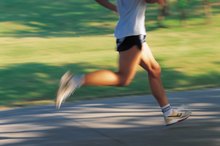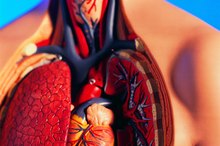The Advantages of Increased Heart Rate During Exercise
Running on a treadmill with a bright red face from a pounding heart might not be the most attractive of looks, but it means your body is working hard to fuel the muscles that function in the run. Speeding up the heartbeat allows blood to flow quicker and more efficiently to the muscles that need the nutrients and oxygen it carries. Furthermore, in the long term, raising your heartbeat through exercise has many beneficial effects on health.
.
Heart Rate Changes
An average person has a heart rate of 70 beats per minute (bpm), but anything within about 60-100 can be normal, according to the Mayo Clinic. A trained athlete, though, can have a healthy resting heart rate of as low as 40 bpm. Each individual beat represents one contraction of the heart, which pushes blood out into the body under pressure. Although the average heart rate is sufficient for normal tasks such as walking or sitting, the body quickly speeds up the heart during exercise.
Increased Blood Flow
How Do the Walls of the Atria & Ventricles Differ?
Learn More
Muscles need glucose and oxygen to move. Blood is the vehicle that drives these items to the muscles. During exercise, the body constricts vessels in areas of the body that do not need as much blood while widening blood vessels to the parts of the body that need more blood. When coupled with the heart's increased pumping due to increased heart rate during exercise, your body is making sure more of the blood volume is be diverted to muscles that need it. According to the University of Maryland Medical Center, the associated increase in blood vessel dilation and the increased blood flow from increasing your heart rate can reduce artery disease development.
Increased Heat Loss
During exercise, muscle activity creates heat. This heat is a by-product of the energy production and usage pathways that the muscle cells use to fuel movement. In fact, your muscle fibers only capture about 30 percent of the released energy for their use. The other 70 percent of the released energy is lost as heat. As overheating is dangerous for the body, this excess heat has to be removed by being released into the environment from the skin. This is where an increased heart rate helps, because the heat is transferred to the capillaries near the skin via blood flow. A faster heart rate means more blood passes under the skin and releases more heat per unit time.
Health Benefits
How Do the Walls of the Atria & Ventricles Differ?
Learn More
People who exercise tend to have lower blood pressure than those who don't, because the heart becomes stronger and does not need to beat as hard to achieve adequate blood circulation. Exercise also helps to reduce bad cholesterol, which also contributes to arterial and coronary disease. Though the exact mechanisms behind why this happens is still being studied, scientists have found that exercise increases enzymes that remove cholesterol from the peripheral tissues.
Related Articles
References
- The University of Arizona: Effects of Exercise on the Cardiovascular System
- University of Maryland Medical Center: Exercise - Exercise's Effects on the Heart
- Mayo Clinic: What's a Normal Resting Heart Rate?
- Pearson Education: Chapter 10 Muscle Tissue
- Guyton and Hall Textbook of Medical Physiology: 12th Edition
- University of New Mexico: A Review of the Impact of Exercise on Cholesterol Levels
- European Heart Journal: An overview of reverse cholesterol transport.
Writer Bio
Jillian O'Keeffe has been a freelance writer since 2009. Her work appears in regional Irish newspapers including "The Connacht Tribune" and the "Sentinel." O'Keeffe has a Master of Arts in journalism from the National University of Ireland, Galway and a Bachelor of Science in microbiology from University College Cork.






